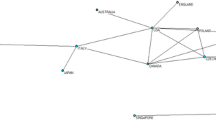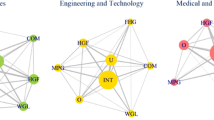Abstract
In this article patterns of international collaboration in science are investigated using a specific procedure to analyse data collected from theScience Citation Index. We develop an indicator based on the scientific linkages between countries established through internationally co-authored articles (COPs). The credibility, advantages and uses of this indicator are discussed. We apply the Correspondence Factorial Analysis method and the Minimum Spanning Tree classification to this indicator in order to observe the level of resemblance and the main characteristics of the collaboration structured by 98 countries in eight principal fields of science. The results shown summarize the diverse aspects of countries participating in collaborative works and bring into view the cognitive structure of international research. The use of these methods in the investigation of international collaboration contributes to the analysis of the complex structure of the scientific communities of different countries.
Similar content being viewed by others
Notes and references
D. de B. Beaver, R. Rosen, Studies in scientific collaboration, Part 1. The professional origines of scientific co-authorship,Scientometrics, 1 (1978) 65–84.
L. A. Lomnitz, M. W. Rees, L. Cameo, Publication and referencing patterns in a Mexican research institute,Social Studies of Science, 17 (1987) 115–133.
L. Kerwin, International science — an overview,Science, 213 (1981) 1069–1072.
Internationalisation of Science and Technology, In:Science and Technology Policy Outlook 1988, OECD, Paris, 1988 31–38.
Science Indicators 1981, National Science Board, Washington D. C., 1981.
J. D. Frame, M. Carpenter, International research collaboration,Social Studies of Science, 9 (1979) 481–497.
J. F. Miquel, La coopération entre le Canada et la France en Science Fondamentale, In:Les enjeux économiques et politiques de l'innovation,M. Leclerc (Ed.), Presses de l'Université du Québec, Québec, 1990, pp. 201–222.
J.W. Tijssen, H.F. Moed, Literature-based statistical analyses of international scientific cooperation — An exploratory case study of the Netherlands, In:Science and Technology Indicators,A.F.J. van Raan et al. (Ed.), DSWO Press, Leiden, 1988, pp. 131–145.
A. Schubert, T. Braun, International collaboration in the sciences, 1981–1985,Scientometrics, 19 (1990) 3–10.
J.C. Doré, J.F. Miquel, Approche de l'Etude des Relations Structure Activité par Analyse des Correspondances,C.R. Académie des Science, 293 (3) (1981) 1061–1064.
E. Bignon, P. Pons, J.C. Doré, J. Gilbert, T. Ojasoo, J.F. Miquel, J.P. Raynaud, A. Crastes de Paulet, Influence of di- and tri-phenylethylene estrogen/antiestrogen structure on the mechanisms of protein kinase C inhibition and activation as revealed by a multivariate analysis,Biochemical Pharmacology, 42 (1991) 1373–1383.
P.M. Carpenter, F. Narin, The adequacy of the Science Citation Index (SCI) as an indicator of international scientific activity,Journal of the American Society for Information Science, 32 (1981) 430–439.
B. Martin, UK scientific performance,Scientometrics 20, (1991) 333–357.
M. Carpenter, International Science Indicators-Development of indicators of international Scientific Activity using the Science Citation Index, Report submitted to National Science Foundation No. SRS77-22770 (1979).
D. Frame, Mainstream research in Latin America and the Caribbean,Interciencia, 2 (1977) 143–148. See also, Science & Engineering Indicators 1989, National Science Foundation (1989), 331.
T. Braun, W. Glänzel, A. Schubert, The bibliometric assessment of UK scientific performance —Some comments on Martin's “Reply”,Scientometrics, 20 (1990) 359–362.
Science & Engineering Indicators 1989, National Science Foundation (1989), 335. See also Ref. 8.
A.F.J. van Raan, R.J.W. Tijssen, An overview of quantitative science and technology indicators based on bibliometric methods,Consequences of the Technology Economy Programme for the Development of Indicators, OECD, 1990.
J.P. Benzécri,L'analyse des données, II. L'analyse des correspondances, Dunod, Paris, 1973.
C. Chatfield, A. J. Collins, Multidimensional scaling and cluster analysis. In:Introduction to Multivariate Analysis, Chapman and Hall, London, 1989 p. 189.
R.C. Prim, Shortest connection networks and some generalizations,Bell System Technology Journal, 36 (1957) 1389.
J. C. Gower, G.J.S. Ross, Minimum spanning trees and single link cluster analysis,Applied Statistics, 18 (1969) 54–64.
J. Devillers, J.C. Doré, Heuristic potency of the minimum spanning tree (MST) method in toxicology,Ecotoxicology Environmental Safety, 17 (1989) 227.
L.L. Lederman, Science and technology policies and priorities: A comparative analysis,Science, 237 (1987) 1125–1133.
T. Braun, I. Gomez, A. Mendez, A. Schubert, International co-authorship patterns in physics and its subfields, 1981–1985,Scientometrics, 24 (1992) 181–200.
G. Ekspong, Contribution to discussion on big science,Nobel Symposium, KVA, 1988.
R. MacLeod, Organizing science under the Southern cross, In:The Commonwealth of Science,R. Macleod (Ed.), Oxford University Press, Melbourne, 1988, p. 19–39. See also pp. 40–72. AndI.D. Rae, Chemists at ANZAAS: Cabbages or Kings? pp. 166–195 in the same collection.
J. El Alami, J.C. Doré, J.F. Miquel, International scientific collaboration in Arab countries,Scientometrics, 23 (1992) 249–263.
Excellence in the midst of poverty,Nature, 12 April (1984).
Y. Okubo, J.F. Miquel, International Scientific Collaboration of Japan: Co-authorship Analysis,Journal of Science Policy and Research Management 6 (4), 1992, 1–16.
Data based on 1986 version of CD-ROM of theScience Citation Index.
The number of international co-authorships (COA) used in this article is supplied by CHI Research Inc.
This Figure is based on the following calculation. Affinity Index for a Country A toward a Country B:Number of Co-operative Linkages between a country A and a country B×100 Number of Co-operative Linkages between a country A and the rest of the world For Affinity Index see:Y. Okubo, J.F. Miquel, International collaboration in basic science, In:Indikatoren der Wissenschaft und Technik-Theorie, Methoden, Anwendungen,P. Weingart et al. (Ed.), Campus, Forschung (1991) 49–71. See also: Research Output, In:Science Indicators 1991 Compendium,J. Gagné (Ed.), Ministère de l'Enseignement Supérieur et de la Science, Québec, 1991, p. 39–49. In these articles we present matrices of different dimensions.
J.J. Salomon, Science, technology and society, In:New Technologies and Development, A. Johnston, A. Sasson (Eds.), UNESCO, Paris, 1986, p. 13–41.
Author information
Authors and Affiliations
Rights and permissions
About this article
Cite this article
Okubo, Y., Miquel, J.F., Frigoletto, L. et al. Structure of international collaboration in science: Typology of countries through multivariate techniques using a link indicator. Scientometrics 25, 321–351 (1992). https://doi.org/10.1007/BF02028090
Received:
Issue Date:
DOI: https://doi.org/10.1007/BF02028090




